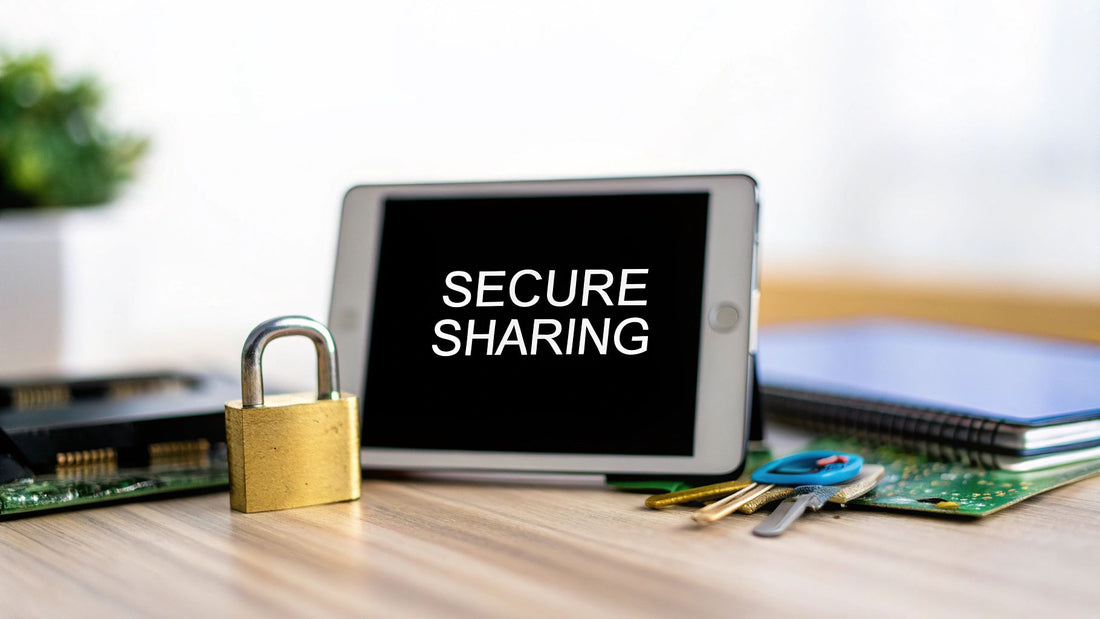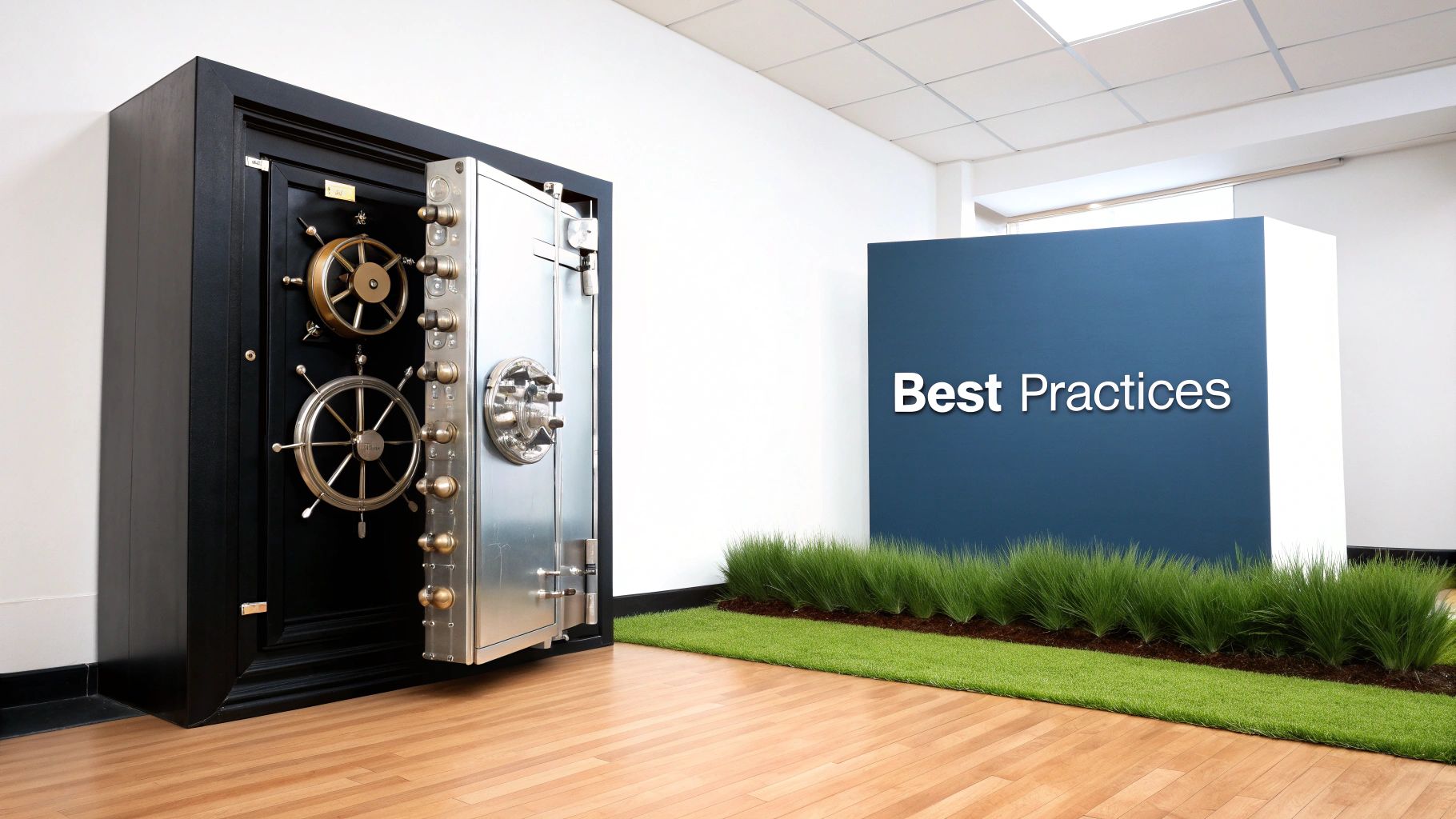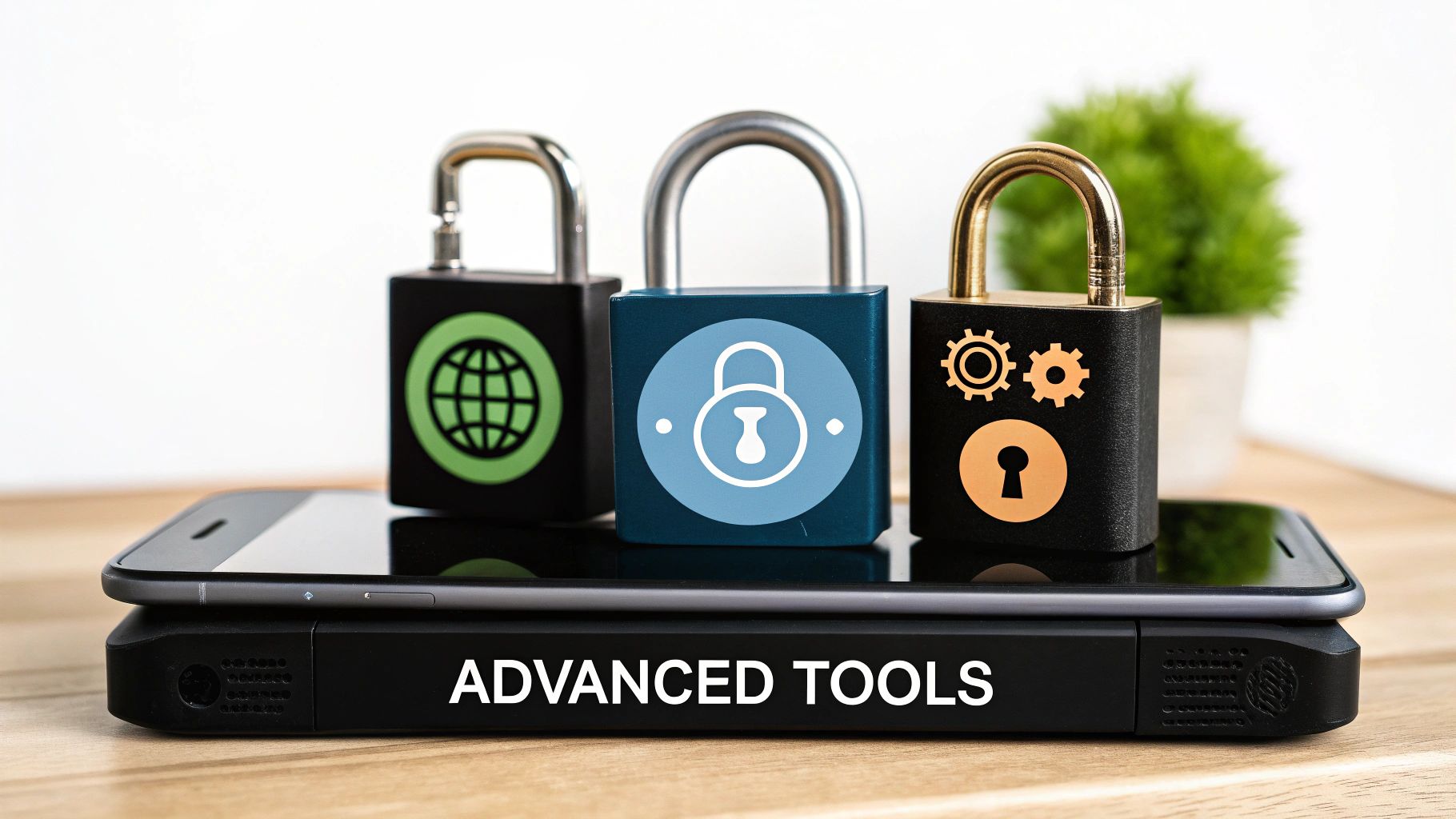
Secure Password Sharing: Expert Tips & Tools
Share
The Modern Password Sharing Challenge

Secure password sharing is essential for both personal and professional collaborations. However, traditional methods, like emailing passwords or jotting them down, create substantial security risks. This presents an ongoing dilemma: balancing the need for shared access with the need to protect sensitive data.
For example, teams often collaborate on projects using shared accounts. But if the credentials for these accounts are compromised, they become easy targets for malicious actors.
One of the core problems is the prevalence of poor password practices. Many individuals and organizations struggle to implement secure password sharing. This often stems from a lack of awareness about the risks and the tools available to mitigate them.
Even with the best intentions, many unknowingly put their data at risk. The sheer number of online accounts we manage also encourages risky shortcuts.
A key contributor to this vulnerability is password reuse. A surprising 78% of people globally admit to reusing passwords across multiple accounts, with 52% reusing the same password for at least three.
In corporate environments, the average employee reuses a password approximately 13 times. This practice creates serious risks, as a breach of one account can easily compromise others. For more on this, check out these Password Statistics.
Why Traditional Methods Fail
Traditional methods often fall short when it comes to modern security threats. Emailing passwords, for example, exposes credentials to interception. Storing passwords in spreadsheets or shared documents offers minimal protection against unauthorized access.
These outdated approaches simply aren't equipped to handle the increasing sophistication of cyberattacks. This highlights the urgent need for more robust and secure password sharing solutions.
The Need for a Structured Approach
Progressive companies are embracing a more structured and secure approach to password sharing. This means moving away from ad-hoc practices and toward solutions that prioritize security without sacrificing usability.
These solutions not only protect against data breaches but also improve access management and boost overall productivity. Adopting secure password sharing isn't just a good idea – it’s a fundamental requirement in today's interconnected world.
Password Managers: Your Secure Sharing Foundation

Modern password managers are more than just password storage. They represent a fundamental change in how we securely share and manage credentials. These tools provide essential features for businesses of all sizes, from encrypted vaults to fine-grained access controls that prevent unauthorized access. This empowers businesses to finally achieve the balance between collaboration and security.
Password managers are becoming a vital tool for secure password sharing and management. While adoption is still increasing, their importance is clear. In the U.S., approximately 36% of adults use password managers, up from 34% the previous year. These tools enable users to create strong, unique passwords for each account, reducing the need to remember multiple passwords and the risks of password reuse. More detailed statistics can be found here.
Key Features of Modern Password Managers
A core component of password managers is the encrypted vault. This vault functions like a digital safe for your passwords, ensuring credentials are protected by strong encryption and inaccessible to unauthorized individuals. Access controls let you specify who can view, edit, or share specific passwords, giving you complete control over sensitive information.
Password managers also offer the crucial ability to generate strong passwords. They can automatically create complex, unique passwords for each account, eliminating the need to remember or reuse weak passwords. This greatly enhances your overall security. For instance, instead of "password123," a password manager might generate "T&j9#Zq$!L%k," making it extremely difficult to crack.
- Encrypted Vaults: Securely store all your credentials.
- Access Controls: Manage sharing with detailed permissions.
- Password Generators: Create strong, unique passwords with ease.
- Secure Sharing: Safely share passwords with colleagues and family.
- Multi-Device Sync: Access your passwords on all your devices.
Real-World Implementation Examples
Different organizations utilize password managers in various ways. A small startup might use a basic password manager for sharing logins for social media accounts and project management tools like Asana. A large enterprise, however, might implement a more comprehensive solution featuring advanced access controls and integration with existing security systems. This adaptability is a key benefit. You might also be interested in: How to master sitemaps.
Here are two specific examples:
-
Healthcare: Hospitals can use password managers to control access to patient records and ensure compliance with regulations like HIPAA. This protects patient privacy by guaranteeing that only authorized personnel can access sensitive data.
-
Finance: Financial institutions can use password managers to secure employee access to critical systems and prevent unauthorized transactions. This protects both the institution and its customers.
Evaluating Password Manager Options
Choosing the right password manager requires considering several factors. Team size, industry requirements, and security needs all play a role. A small team with basic security needs might choose a free or low-cost solution, while a larger enterprise with strict compliance needs might choose a premium platform like 1Password or LastPass.
Collaboration workflows and budget are also important. The right password manager should integrate smoothly with your existing workflows and fit your budget without compromising security. This ensures wide adoption and effectively strengthens your security.
To help you compare options, consider the following table:
Password Manager Feature Comparison Comparison of key features across popular password management solutions
| Feature | Enterprise Solutions | Team Solutions | Personal Solutions |
|---|---|---|---|
| Encrypted Vaults | Yes | Yes | Yes |
| Access Controls | Advanced, granular permissions, often with role-based access | Shared vaults, group permissions | Typically individual access, some sharing features |
| Password Generators | Yes, customizable complexity | Yes | Yes |
| Secure Sharing | Secure sharing within the organization, audit logs | Secure sharing within the team | Secure sharing with individuals |
| Multi-Device Sync | Yes, across all devices | Yes, across multiple devices | Yes, typically across multiple devices |
| Reporting and Auditing | Comprehensive reporting and audit trails | Basic reporting and activity logs | Limited or no reporting |
| Integration with other systems | Integration with SSO, Active Directory, and other security systems | Integration with common team tools | Limited integrations |
This table highlights the differences in features offered by password managers designed for different use cases. Enterprise solutions offer the most comprehensive features, while personal solutions focus on individual use. Team solutions fall somewhere in between, catering to the needs of smaller groups.
Elevating Security Through Multi-Factor Authentication

Multi-factor authentication (MFA) adds a vital layer of security to password sharing. It transforms a potentially vulnerable system into one significantly more resilient. Instead of relying solely on a password, MFA demands additional verification, making unauthorized access much harder.
This enhanced security comes from the multiple "factors" required for verification. These typically fall into three categories: something you know (like a password), something you have (like a phone or security token), and something you are (like a fingerprint). This combined approach makes it much more difficult for unauthorized users to gain access.
MFA is rapidly becoming essential for secure password practices. Globally, approximately 57% of businesses have adopted MFA, a significant increase in recent years. Surprisingly, only a small percentage of these businesses enforce MFA through policy, highlighting a concerning gap in security practices. For a deeper dive into these statistics, check out this report from LastPass.
Understanding Different MFA Approaches
Various MFA methods exist, each with its own advantages and disadvantages. Authenticator apps generate time-based one-time passwords (TOTPs) on your phone, providing an extra layer of security. Hardware security keys, such as Yubikeys, offer a physical token required for login. Biometric verification, like fingerprint or facial recognition, provides convenience but can be less secure.
MFA and Password Managers: A Powerful Combination
Using MFA with a password manager creates a robust defense against unauthorized access. Even if a password is compromised, the additional authentication factors make it extremely difficult for an attacker to gain entry. This is especially critical when passwords are shared amongst team members. You might find this resource helpful: How to master blog sitemaps.
Implementing MFA Effectively
Successful MFA implementation requires careful planning. Minimizing friction points for users is paramount. If MFA is too cumbersome, users may try to circumvent it, negating its purpose. Ensuring adoption across all team members, regardless of technical expertise, requires clear communication and training.
Here are some tips for a smooth rollout:
- Start with the most secure options: Prioritize hardware keys and authenticator apps whenever possible.
- Educate your team: Clearly explain the benefits of MFA and how it strengthens security.
- Provide clear instructions: Make the setup process easy to follow.
- Offer support: Be readily available to answer questions and troubleshoot any issues.
By following these strategies, organizations can significantly reduce the risk of unauthorized access, even in the event of a compromised password. This proactive approach establishes a strong security posture and protects valuable data.
The Future of Secure Credential Sharing

The world of secure password management is constantly changing. New technologies offer both better security and a more streamlined experience for users. This evolution suggests a future where traditional passwords become a thing of the past, replaced by more secure and user-friendly methods.
Exploring Passwordless Authentication
The shift toward passwordless authentication is a major change in how we approach secure credential sharing. Several key technologies are driving this change, including biometrics, passkeys, and token-based systems. Progressive organizations are already adopting these technologies, paving the way for wider use. As technology continues to improve, options like biometrics and passkeys are becoming increasingly attractive. A recent survey showed 56% of respondents were interested in passwordless authentication, with 50% open to using biometrics. In the business world, almost half of companies are exploring or deploying passwordless solutions, particularly focusing on biometric technologies. For a deeper dive into these statistics, check out this blog post.
-
Biometrics: These methods use unique biological traits like fingerprints, facial recognition, or iris scans to verify users. This provides both convenience and robust security. Unlocking your phone with your fingerprint is a perfect example.
-
Passkeys: Think of passkeys as unique digital keys for each online account, stored securely on your device. They offer strong protection against phishing and data breaches.
-
Token-Based Systems: These systems generate a unique, temporary code (a token) for every login attempt. This removes the need for static, easily compromised passwords. Many Multi-Factor Authentication systems use one-time passwords, sometimes delivered via SMS. If you’re interested in the security implications of this, you can read more about OTP over SMS.
Integrating with Existing Security Frameworks
These new technologies aren’t designed to completely replace existing security measures. Instead, they work alongside and strengthen them. For example, passwordless methods can be used in conjunction with multi-factor authentication for even stronger protection. This layered approach creates a significantly more secure environment.
Transitioning to Passwordless
Moving away from traditional passwords requires careful planning. The transition involves several key steps, including user education, adapting current systems, and gradually implementing the new technologies. A phased rollout allows organizations to manage the change effectively and minimize any disruptions, ultimately leading to a more secure and user-friendly experience.
Building Your Secure Password Sharing Playbook
Creating a truly effective secure password sharing policy requires finding the right balance. You need strong protection, but it can't come at the cost of usability. A policy that's too complex will be ignored, or worse, actively circumvented. This defeats the entire purpose. This section explores creating a policy that encourages adoption and genuinely reduces risk.
Essential Components of a Secure Password Sharing Policy
A successful policy addresses the realities of password sharing while maintaining security. It clearly defines acceptable methods, approved tools (like password managers), and the consequences of not following the rules. This clarity establishes a framework that everyone can understand and, more importantly, follow.
- Clear Guidelines: Define acceptable sharing methods and approved tools.
- Password Manager Mandate: Require the use of a reputable password manager.
- MFA Requirement: Enforce multi-factor authentication (MFA) wherever possible.
- Access Controls: Implement clear access levels and permissions.
- Regular Audits: Periodically review access rights and activity logs.
- Incident Response Plan: Outline the steps to take if a security breach occurs.
Customizable Policy Templates
Different industries have different needs. A customizable policy template allows you to address these nuances. Adapt a template to align with your specific industry regulations, security requirements, and organizational structure. This flexibility ensures the policy is relevant and actionable.
For example, a healthcare organization's policy must comply with HIPAA, while a financial institution's policy must prioritize preventing unauthorized transactions. A small business likely needs a simpler policy than a large enterprise.
Gaining Stakeholder Buy-In
A policy is only as effective as its adoption rate. Getting buy-in from everyone, from employees to management, is essential. Explain the why behind the policy. Focus on the benefits, not just the restrictions. Highlight how secure password sharing protects both the organization and individual team members.
For example, show employees how the policy helps protect their personal information and reduces their risk of identity theft. For management, emphasize how the policy reduces the organization's risk of costly data breaches and reputational damage.
Progressive Enforcement Mechanisms
Rolling out a new policy shouldn't happen overnight. A progressive approach allows everyone time to adapt. Start with education and training on the new procedures. Then, gradually increase enforcement, beginning with warnings and eventually moving to stricter consequences for non-compliance. This method promotes adoption and reduces resistance.
Measuring Effectiveness
How do you know if your policy is working? Establish clear metrics and compliance indicators. Track password manager usage, MFA adoption rates, and the number of security incidents related to password sharing. This data offers concrete evidence of the policy's effectiveness. Use this information to identify areas for improvement and refine your policy over time.
Security Risks by Password Sharing Method
Before we wrap up, let's look at a breakdown of the risks associated with various password sharing methods. This analysis will help inform your policy development. The table below provides a clear comparison:
Security Risks by Password Sharing Method: Analysis of various password sharing methods and their associated security risks
| Sharing Method | Risk Level | Common Vulnerabilities | Recommended Mitigations |
|---|---|---|---|
| Email/Text | High | Interception, Lack of Control | Password Manager, MFA |
| Spreadsheets/Documents | Medium | Unauthorized Access, Version Control Issues | Password Manager, Access Controls |
| Sticky Notes | High | Physical Theft, Loss | Password Manager |
| Verbal Sharing | Medium | Eavesdropping, Forgotten Passwords | Password Manager, MFA |
As you can see, traditional sharing methods have significant vulnerabilities. This highlights the importance of adopting more secure practices. By directly addressing these risks, organizations can strengthen their overall security and protect sensitive data from unauthorized access. A robust secure password sharing policy, combined with the right tools and training, is no longer a luxury, but a necessity in today's business environment.
Secure Password Sharing In Action: Success Stories
Sharing passwords securely isn't just a best practice; it's a necessity in today's interconnected world. But how are organizations successfully implementing secure password sharing in their daily operations? This section explores real-world examples of companies that transformed their password habits and achieved measurable security improvements.
Healthcare: Protecting Patient Data
Imagine a healthcare provider grappling with inconsistent password practices across multiple departments. Shared logins for crucial systems were commonplace, creating significant vulnerabilities. By implementing a robust password manager and enforcing multi-factor authentication (MFA), the provider restricted access to sensitive patient data to only authorized personnel. This action not only bolstered security but also ensured compliance with regulations like HIPAA. The result? A significant decrease in security incidents and a boost in patient trust.
Finance: Securing Financial Transactions
Financial institutions constantly face evolving threats. Consider a bank relying on outdated methods for sharing passwords related to vital financial systems. This practice presented a considerable risk of unauthorized transactions. By adopting a password manager with granular access controls, the bank established a secure system for managing employee credentials. This change mitigated the risk of both internal and external threats, effectively protecting the institution and its customers.
Technology: Streamlining Access For Development Teams
In the fast-paced technology sector, collaboration is essential. A software development company, with multiple teams working on various projects, needed a secure way to share access to code repositories and testing environments. Using a password manager with group permissions allowed the company to streamline access without compromising security, enhancing productivity while safeguarding their intellectual property. Additionally, they implemented a clear policy for revoking access when employees departed, addressing a critical security gap.
Small Business: Simplifying Security Without Complexity
Even small businesses are vulnerable to security breaches. A local marketing agency, for example, needed a straightforward yet secure method for sharing passwords for social media accounts and client dashboards. A user-friendly password manager provided an easy-to-implement and maintain solution, protecting client data and the agency's reputation. This simplified their workflow without the need for complex IT infrastructure.
Adaptable Roadmaps For Your Organization
These success stories are not isolated incidents but rather represent a growing trend of organizations recognizing the critical importance of secure password sharing. You might be interested in: How to master sitemaps. Whether a large enterprise or a small business, these examples demonstrate practical strategies adaptable to different organizational sizes, industry requirements, and security maturity levels.
Key takeaway: Secure password sharing is achievable and beneficial across various environments. Learning from these successes provides valuable insights for developing your own robust password management strategy.
Ready to improve your password sharing practices? Discover AccountShare, the platform that empowers you to share access to premium services securely and cost-effectively.
